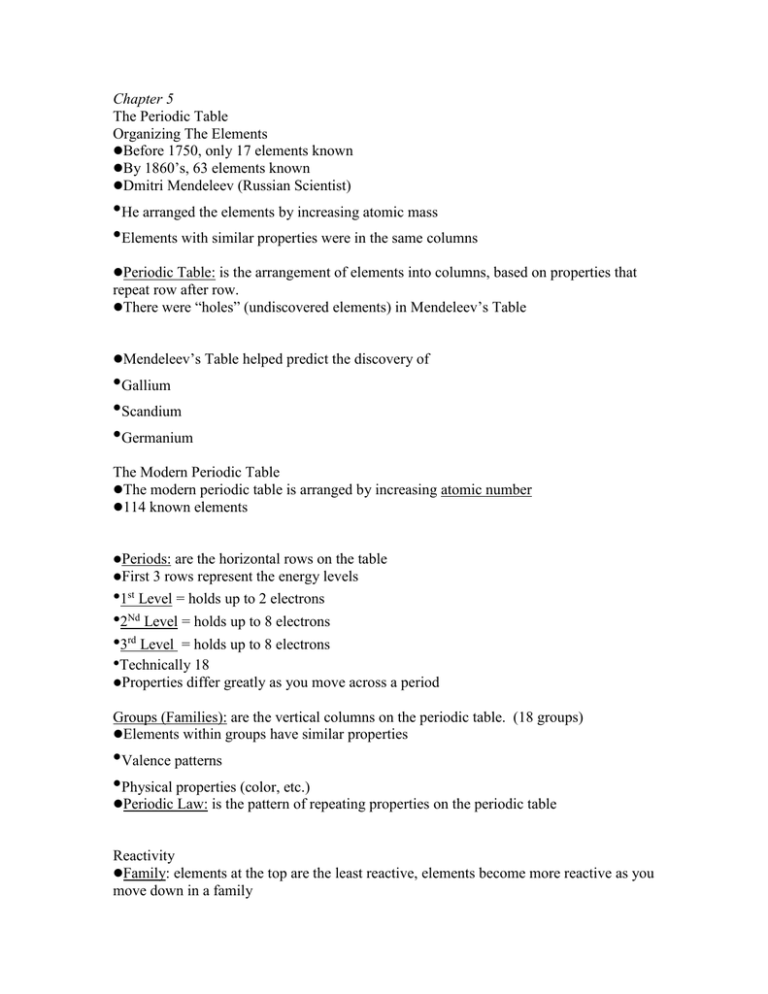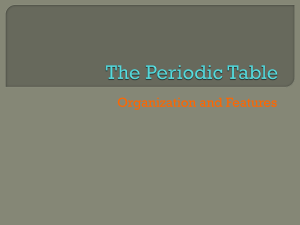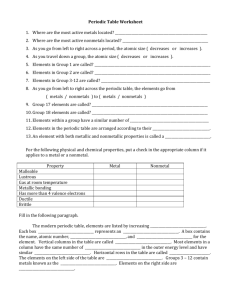Chapter 5 The Periodic Table Organizing The Elements
advertisement

Chapter 5 The Periodic Table Organizing The Elements Before 1750, only 17 elements known By 1860’s, 63 elements known Dmitri Mendeleev (Russian Scientist) •He arranged the elements by increasing atomic mass •Elements with similar properties were in the same columns Periodic Table: is the arrangement of elements into columns, based on properties that repeat row after row. There were “holes” (undiscovered elements) in Mendeleev’s Table Mendeleev’s Table helped predict the discovery of •Gallium •Scandium •Germanium The Modern Periodic Table The modern periodic table is arranged by increasing atomic number 114 known elements Periods: are the horizontal rows on the table First 3 rows represent the energy levels •1st Level = holds up to 2 electrons •2Nd Level = holds up to 8 electrons •3rd Level = holds up to 8 electrons •Technically 18 Properties differ greatly as you move across a period Groups (Families): are the vertical columns on the periodic table. (18 groups) Elements within groups have similar properties •Valence patterns •Physical properties (color, etc.) Periodic Law: is the pattern of repeating properties on the periodic table Reactivity Family: elements at the top are the least reactive, elements become more reactive as you move down in a family Periods: elements on the far right (noble gases) are NON-REACTIVE, elements on the left are more reactive Atomic Mass Average Atomic Mass: is the average mass of all of an element’s isotopes (remember to round when calculating the number of neutrons) Atomic Mass Units Atomic Mass Units: unit assigned to measuring the mass of protons, neutrons, and electrons (rounded atomic mass) Abbreviated as A.M.U. Classes of Elements Metals: Good conductors of heat and electricity Solid at room temp. (except mercury) Malleable: hammered into thin sheets Ductile: drawn into wire (copper) Luster: metals have a shine Oxidation: metals react with oxygen (rust) Nonmetals: Poor conductors of heat and electricity Some solids, liquids, gases at room temp. Brittle: nonmetal solids are not malleable or ductile (they break easily) Nonmetals do not have a luster (shine) Nonmetals do not oxidize Metalloids: Elements along the staircase These are elements that show properties of both metals and nonmetals Silicon = semi-conductor (computers) Valence Electrons Valence electrons: electrons in the outermost energy level, these are the electrons with the highest energy. Elements in the same family have similar properties because they have the same number of valence electrons Valence electrons determine how elements chemically bond.








